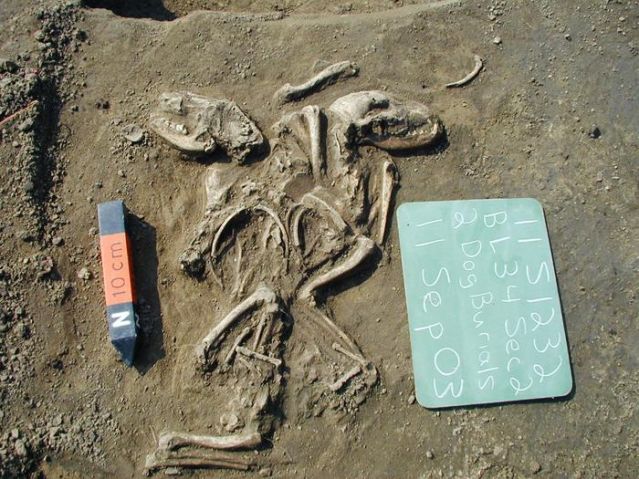Genetics
The First Dogs in the Americas
What did the first dogs in the Americas look like and where did they come from?
Posted January 27, 2015
Over the past 20 years some new research techniques have allowed us to begin to answer the question of where dogs originally came from, or more specifically where and when they were originally domesticated, and how they spread around the world. However some intriguing puzzles remain. There is a scientific consensus that dogs were originally domesticated in southern or central Asia 11,000 to 16,000 years ago, however since the concept of a dog was such a good idea, it is possible that there have been several separate domestication's at different times and places around the world. If we stick with the notion that dogs started in Asia then the question becomes how and when did dogs make their way to the Americas?
A recent study published in the Journal of Human Evolution* was headed by Kelsey Witt from the School of Integrative Biology at the University of Illinois at Urbana-Champagne and tried to address these questions. The study reported data on the remains of 84 dogs including 34 from a single burial site located near the ancient city of Cahokia in what is now southern Illinois. It dates back about 1000 to1400 years. Here scientists found dozens of dogs that were ceremonially buried, suggesting that the people of that time had a special reverence for dogs. While most of the dogs were buried individually, some were placed back-to-back in pairs.

The technical aspect of the research involved an examination of the mitochondrial DNA from these animals. Mitochondrial DNA is easier to obtain from ancient remains then the DNA found in the nucleus of cells. A special feature of mitochondrial DNA is that it is passed on directly only from the mother. This means that it offers researchers an unbroken line of inheritance back through the past, theoretically to the first mother of dogs. It also provides a sort of a rough timeline, since the mitochondrial DNA should not change, and can only be altered by mutations. We have a reasonable guess as to how many such mutations in the DNA might be expected over time periods such as centuries. Based on the analysis of this genetic material, the researchers manage to provide some interesting answers about the history of dogs in the New World, but the data leaves some questions unresolved.
It is believed that human beings entered North America somewhere between 15,000 to 20,000 years ago. People came to the Americas by trudging across a land bridge that extended from Siberia to Alaska and which disappeared some 10,000 years ago. Witt explained "We were interested in seeing if we could see when dogs arrived in the Americas. It's assumed that they came with humans but no one actually looked at it."
The first thing that the researchers found was a surprise. Based on the changes in the mitochondrial DNA that served as their time clock, it appears that dogs arrived in North America around 10,000 years ago, which would be several thousand years after the first humans appeared here, and just before the disappearance of the land bridge. This late arrival of dogs suggests that after the original influx of humans there may have been a second major migration of people bringing a new batch people, this time with their dogs, to the New World.
Once dogs arrived in North America they quickly spread, and made their way all the way down to South America. Tracing the migration of the dogs tells us something about human geographic movements. In fact, tracing the early history of dogs may give us insight into prehistoric human history. Witt puts it this way, "Dogs are one of the earliest organisms to have migrated with humans to every continent, and I think that says a lot about the relationship dogs have had with humans. They can be a powerful tool when you're looking at how human populations have moved around over time." She goes on to note that human remains are not always available for study "because of living populations who are very connected to their ancestors and in some cases may be opposed to the destructive nature of genetic analysis." Analysis of ancient dog remains is often permitted when analysis of human remains is not, she said.
The dogs arriving in the Americas were genetically similar to European wolves and according to Witt the prevalent theory is that some of these dogs went on to breed with American wolves. She suggests that some of these hybrids may later have been "re-domesticated" to give us different lines of dogs, particularly some of those in the northern regions of the continent.
Could it be that dogs arrived in North and South America on their own? Witt definitely thinks that this is not the case. "The assumption is that humans chose to bring them. I would imagine they were brought because they were useful to the people who brought them. For whatever reason, they felt they would be helpful as they were migrating." She goes on to suggest that the dogs were being kept for much the same reasons that people have dogs today. The research report notes that dogs were being ceremonially buried more than 9000 years ago, only a short time after they arrived on the continent, and this certainly suggests that there was respect and an emotional bond between these early dogs and the humans who kept them.

While there are still questions about the arrival of dogs in the Americas, the existence of actual skeletons does allow us to determine what these early dogs looked like. A reconstruction would look much like this drawing.
To my eye at least, these ancient American dogs look very similar to modern Australian dingoes.
Stanley Coren is the author of many books including: The Wisdom of Dogs; Do Dogs Dream? Born to Bark; The Modern Dog; Why Do Dogs Have Wet Noses? The Pawprints of History; How Dogs Think; How To Speak Dog; Why We Love the Dogs We Do; What Do Dogs Know? The Intelligence of Dogs; Why Does My Dog Act That Way? Understanding Dogs for Dummies; Sleep Thieves; The Left-hander Syndrome
Copyright SC Psychological Enterprises Ltd. May not be reprinted or reposted without permission
* Data from: Kelsey E. Witt, Kathleen Judd, Andrew Kitchen, Colin Grier, Timothy A. Kohler, Scott G. Ortman, Brian M. Kemp, Ripan S. Malhi. (2014), DNA analysis of ancient dogs of the Americas: Identifying possible founding haplotypes and reconstructing population histories. Journal of Human Evolution, http://dx.doi.org/10.1016/j.jhevol.2014.10.012




